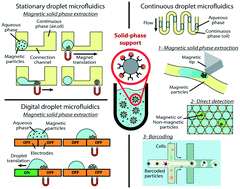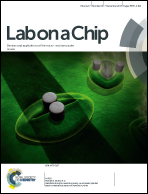The power of solid supports in multiphase and droplet-based microfluidics: towards clinical applications
Abstract
Multiphase and droplet microfluidic systems are growing in relevance in bioanalytical-related fields, especially due to the increased sensitivity, faster reaction times and lower sample/reagent consumption of many of its derived bioassays. Often applied to homogeneous (liquid/liquid) reactions, innovative strategies for the implementation of heterogeneous (typically solid/liquid) processes have recently been proposed. These involve, for example, the extraction and purification of target analytes from complex matrices or the implementation of multi-step protocols requiring efficient washing steps. To achieve this, solid supports such as functionalized particles (micro or nanometric) presenting different physical properties (e.g. magnetic, optical or others) are used for the binding of specific entities. The manipulation of such supports with different microfluidic principles has both led to the miniaturization of existing biomedical protocols and the development of completely new strategies for diagnostics and research. In this review, multiphase and droplet-based microfluidic systems using solid suspensions are presented and discussed with a particular focus on: i) working principles and technological developments of the manipulation strategies and ii) applications, critically discussing the level of maturity of these systems, which can range from initial proofs of concept to real clinical validations.

- This article is part of the themed collection: Lab on a Chip Recent Review Articles


 Please wait while we load your content...
Please wait while we load your content...